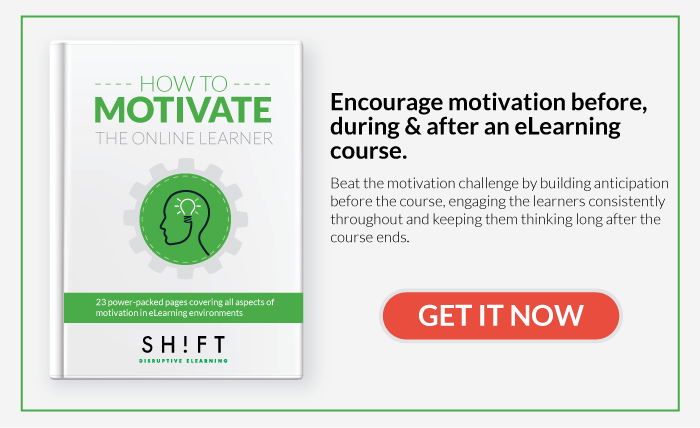What’s the first thing you do when you’re about to create a new eLearning course? Do you jump right into the eLearning tool, or maybe think that with AI, most of the work is already handled?
If you’re leaning toward the latter, here’s a little secret: while AI is powerful and technology makes things faster, they’re no substitute for the clear strategy you and your team need at the start.
It’s easy to think that, with today’s tech, all it takes is pressing a button to get a course ready to go.
But here’s the truth: before you let creativity flow and let technology take the wheel, you need a solid, well-thought-out plan.
And that starts with answering four key questions. These questions are your safety net, keeping your course from becoming a waste of time and money and turning it into something that actually makes an impact.
Making an impact means connecting with the right people, delivering the right message, using relatable examples, and making sure participants can put their new knowledge to work.
So, before jumping into your favorite eLearning tool or letting AI work its magic, take a moment to ask yourself these crucial questions:
1) WHO ARE THEY? Identifying the Audience Taking the Course
Knowing your audience isn’t just a step in the process—it’s the secret sauce that makes your course actually useful.
Picture this: you launch a course without a clear picture of who’s taking it. It’s like serving a fancy five-course meal without checking for allergies or dietary preferences. Not exactly a winning move, right?
If your eLearning course doesn’t speak to what your team actually needs, it’s likely to flop. No one wants a course that feels like busywork.
Here’s why taking the time to know your course audience is a must:
-
Skip the Obvious and the Overly Complex: Covering things they already know or, on the flip side, stuff that’s way over their heads can either bore them or leave them scratching theirs.
-
Hit on Real, Practical Needs: If the course doesn’t tackle what they actually face on the job, it’s just not going to feel relevant—or worth their time.
-
Keep Their Interest: When team members can clearly see how the course helps them, they’re way more likely to stick with it (and maybe even enjoy it!).
Here are a few questions to make sure your course is actually hitting home:
-
Audience Basics: Who are they? What skills do they already have, and what are they hoping to build?
-
Daily Life: What does a typical day look like? Are they on Zoom calls all day or juggling a hundred things at once?
-
Work Environment: What’s the vibe? Is it all about collaboration, competition, or somewhere in between?
-
Why They’re Taking the Course: Are they here by choice or because it’s required? This will change how you approach the course content.
-
Current Knowledge: How much do they already know? If they’re already pros, you don’t need to start at square one.
By answering these questions, you’re setting the course up to be more than just “one more thing to do.” It’ll be a practical tool that boosts their skills, addresses their real needs, and helps them make a difference in their work.
Also read: These 27 Questions Will Help You (Really) Know Your Learners
2) WHY DOES THIS MATTER? Why It’s Crucial for Your Team to Take This Training
Here’s the deal: whether you’re building this course yourself or letting AI work its magic, you need a rock-solid understanding of why this training matters before you dive in.
Why? Because people only get engaged if they know what’s in it for them. And that’s not just a nice-to-have—it’s the foundation for building a course that actually delivers results.
When you’re clear on the why upfront, you’re setting your course up for success. You’re not just creating random lessons; you’re designing something valuable that resonates with your team’s real needs. If you skip this, no amount of AI magic or design work will turn things around later.
Here’s how to make your course not just necessary, but something they’ll actually want to take:
-
Be Clear About the Benefits: Right from the start, let them know what they’re getting out of this. Will it make them better at their current job? Give them a leg up for a promotion? Spell it out, and keep highlighting these benefits as they go.
-
Make It Real: Use real-life examples that show how they can put what they’re learning into action. If it’s a course on time management, add a module on how to apply these techniques in a regular workday—it’s practical, and it keeps things relatable.
-
Keep It Fun and Interactive: Toss in questions that make them think, add quick quizzes, and keep it lively. A little interaction goes a long way to hold their attention (and yes, maybe a few laughs too).
-
Experts and Success Stories: Add in short videos from experts or quick success stories from people who’ve already used these skills. Seeing real people share how it helped them can be super motivating.
-
Give Immediate Takeaways: Design each module so they can try out what they’ve learned right away. If they can see the value immediately, they’re way more likely to stick with it (and appreciate it).
So, before you let AI start building your course or jump into designing it yourself, make sure you’re clear on why this training matters to your team. This is the foundation that turns training from just another task into a true asset for their growth and success.
Focus on these areas, and you’ll turn training into something they value—not just one more thing on their to-do list.
Also read: Why You Should Be Designing eLearning Courses Backwards
3) WHAT? What Should Your Team Be Able to Do After Finishing the Course?
This question is a biggie—and it should guide every decision you make when creating the course, whether you’re building it yourself or using AI to help out.
Here’s the thing: if you’re just loading up a course with endless data and theories that read like a blender manual, people are going to tune out fast.
What really matters is making sure the content connects to your team’s real needs and work-life realities.
If you don’t have a clear idea of what your team should be able to do by the end of the course, you’re likely setting up a training that’ll be forgotten as soon as they click “Complete.”
Instead, think about the situations where they’ll actually apply this knowledge. Knowing this upfront keeps you (and any AI you’re using) focused on creating something useful, relevant, and engaging.
Here’s how to make it crystal clear what skills and knowledge your team will walk away with:
-
Clear Kick-Off: Start each module with simple, straightforward goals. A quick bullet-point list like, “By the end, you’ll be able to…” sets expectations and gets people interested.
-
Visual Reminders: Use infographics or simple diagrams at the beginning and end of each section to highlight goals. It keeps things easy to follow and remember.
-
Engage Throughout: Add in reflection questions or quick check-ins, like “How would you use this on your next project?” It keeps the content grounded in real-world application, not just theory.
-
Hands-On Practice: Design activities that actually get them using what they’ve learned. If you’re teaching presentation skills, have them record a quick pitch or share a mini-presentation—something practical they can see value in right away.
-
Meaningful Feedback: Provide specific feedback that connects their activities directly to the course goals. This not only reinforces what they’ve learned but makes it clear why each task matters.
-
Wrap-Up with Impact: At the end, do a quick review of all the goals covered. Whether it’s a Q&A, a visual summary, or a downloadable sheet, give them something they can refer back to.
As Malcolm Knowles, the guru of adult learning, said, “Adult learning is life-centered.” People want to learn things they can actually use to make their lives easier or their work more effective. By getting clear on these “What” goals upfront, you’re creating a course that’s memorable, practical, and, best of all, truly worth their time.
Also read:
6 Essential Content Creation Tips For eLearning Success
5 Rules for Creating Relevant and Fluff-free Courses
Before Diving Into Your Favorite eLearning Tool, Ask Yourself:
Do I Really Get What My Team Needs?
Will This Course Actually Help Them Do Their Jobs Better?
Let’s be real—this isn’t just about throwing information at people. The goal here is to help your team not only learn but actually use that knowledge in ways that make a difference.
Here’s Your Quick-Start Checklist:
-
Get to Know Your Audience: Take a deep dive into their needs, current skills, and the real challenges they’re dealing with every day. (No guessing!)
-
Set Clear, Doable Goals: Outline learning objectives that actually mean something to your team and tie back to the results you’re aiming for.
-
Make It Interactive: Give them ways to practice, apply, and get feedback on what they’re learning. Think less “lecture” and more “let’s try it out!”
-
Check and Tweak as You Go: At the end of the course, ask for feedback and adjust if needed. Make sure the course hits the mark and actually helps them grow.
By focusing on these steps, you’ll design a course that’s worth every minute of their time and foster a culture of ongoing learning that can truly boost performance.
Remember: a great eLearning course doesn’t just teach—it transforms. (And hey, if you can make it fun, even better!)



